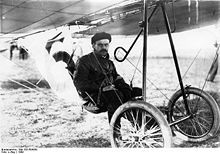Grade II
| Grade II dragonfly | |
|---|---|

|
|
| Type: | Trainer aircraft |
| Design country: | |
| Manufacturer: | |
| First flight: |
17th August 1909 |
| Commissioning: |
1909 |
| Production time: |
1909 to 1914 |
| Number of pieces: |
80 |
The Grade II Libelle was a single-engine training aircraft developed by the German engineer and entrepreneur Hans Grade . The machine is considered to be the first truly airworthy German powered aircraft. Hans Grade won the Lanz Prize of the Skies with his dragonfly on October 30, 1909 .
history
After the first short leaps in the air in a self-designed triplane in 1908, Hans Grade developed the Libelle , a light monoplane , for which he himself designed and built a four-cylinder two-stroke engine weighing just 40 kg with around 16 hp. The construction was based on the Santos-Dumont Demoiselle (French Demoiselle = German dragonfly). Grade made the first flight on August 17, 1909 in Bork . On October 30, 1909, he was the first to meet the requirements of the Lanz Prize of the Air with this aircraft at the first International Flight Week at Johannisthal Airport . That brought him the prize money of 40,000 marks.
The original machine was handed over to the Deutsches Museum in 1917 . A replica is in the Magdeburg Technology Museum . Another replica is in the Dresden Transport Museum . This specimen consists for the most part of original substance.
construction
The wing and the tail unit were a canvas-covered wooden rib construction. The hull was made of steel and bamboo cane. The entire construction was braced with external ropes for stabilization. The bank was checked by twisting the wing. The pilot sat outside the fuselage between the wing and the main landing gear.
use
Due to the success of the Libelle in Johannisthal, the machine was initially used on sightseeing flights in various German cities. From 1910 to 1914 Grade produced them in series in a specially founded aircraft factory in Bork and used them in his flight school, where it proved to be very effective. Many of the first German pilots learned to fly on the dragonfly . The machine could be purchased for 12,000 marks including flight training. This made it the cheapest aircraft of its time.
Technical specifications
| Parameters | Data |
|---|---|
| crew | 1 |
| Passengers | - |
| length | 7.3 m |
| span | 10.2 m |
| Wing area | 25 m² |
| Wing extension | 4.2 |
| Empty mass | 125 kg |
| Takeoff mass | 200 kg |
| Cruising speed | 60 km / h |
| Engine | air-cooled 4-cylinder two-stroke engine from Hans Grade with 12 kW (16 HP ), weight 40 kg |
Trivia
In 1998, a grade "dragonfly" was built by Heinz Linner in the Berlin-Köpenick yacht yard according to Linner's plans, removed from the original in the Deutsches Museum, in ABM. The machine is airworthy. In the absence of an original engine, a mock-up of the grade engine was installed. The aircraft is currently (2008) at Fürstenwalde airfield .
See also
literature
- Karl-Dieter Seifert: Hans Grade. A life in stormy times. Magdeburg 2008, ISBN 978-3-938247-98-3 .
- Günter Schmitt, Werner Schwipps: Pioneers of early aviation. Gondrom Verlag, Bindlach 1995, ISBN 3-8112-1189-7
Web links
Individual evidence
- ↑ a b Grade monoplane, 1909. In: Propellerflugzeuge. Deutsches Museum, accessed on March 24, 2016 .
- ^ Motorplanes - Hans Grade on the museum website, accessed on March 24, 2016
- ↑ a b The Grade Monoplane. (PDF) In: FLIGHT, DECEMBER 11, 1909. Flightglobal.com , December 11, 1909, pp. 791–792 , accessed on October 31, 2014 (English, detailed description with dimensional drawing).


